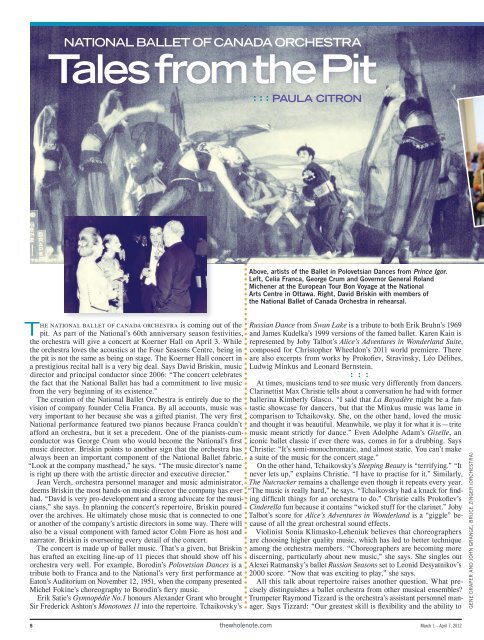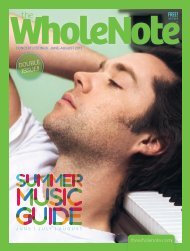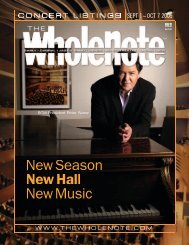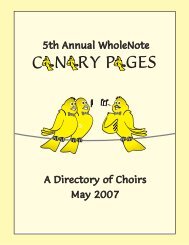NATIONAL BALLET OF CANADA ORCHESTRATales from the Pit: : : PAULA CITRONThe national ballet of canada orchestra is coming out of thepit. As part of the National’s 60th anniversary season festivities,the orchestra will give a concert at Koerner Hall on April 3. Whilethe orchestra loves the acoustics at the Four Seasons Centre, being inthe pit is not the same as being on stage. The Koerner Hall concert ina prestigious recital hall is a very big deal. Says David Briskin, musicdirector and principal conductor since 2006: “The concert celebratesthe fact that the National Ballet has had a commitment to live musicfrom the very beginning of its existence.”The creation of the National Ballet Orchestra is entirely due to thevision of company founder Celia Franca. By all accounts, music wasvery important to her because she was a gifted pianist. The very firstNational performance featured two pianos because Franca couldn’tafford an orchestra, but it set a precedent. One of the pianists-cumconductorwas George Crum who would become the National’s firstmusic director. Briskin points to another sign that the orchestra hasalways been an important component of the National Ballet fabric.“Look at the company masthead,” he says. “The music director’s nameis right up there with the artistic director and executive director.”Jean Verch, orchestra personnel manager and music administrator,deems Briskin the most hands-on music director the company has everhad. “David is very pro-development and a strong advocate for the musicians,”she says. In planning the concert’s repertoire, Briskin pouredover the archives. He ultimately chose music that is connected to oneor another of the company’s artistic directors in some way. There willalso be a visual component with famed actor Colm Fiore as host andnarrator. Briskin is overseeing every detail of the concert.The concert is made up of ballet music. That’s a given, but Briskinhas crafted an exciting line-up of 11 pieces that should show off hisorchestra very well. For example, Borodin’s Polovetsian Dances is atribute both to Franca and to the National’s very first performance atEaton’s Auditorium on November 12, 1951, when the company presentedMichel Fokine’s choreography to Borodin’s fiery music.Erik Satie’s Gymnopédie No.1 honours Alexander Grant who broughtSir Frederick Ashton’s Monotones 11 into the repertoire. Tchaikovsky’sAbove, artists of the Ballet in Polovetsian Dances from Prince Igor.Left, Celia Franca, George Crum and Governor General RolandMichener at the European Tour Bon Voyage at the NationalArts Centre in Ottawa. Right, David Briskin with members ofthe National Ballet of Canada Orchestra in rehearsal.Russian Dance from Swan Lake is a tribute to both Erik Bruhn’s 1969and James Kudelka’s 1999 versions of the famed ballet. Karen Kain isrepresented by Joby Talbot’s Alice’s Adventures in Wonderland Suite,composed for Christopher Wheeldon’s 2011 world premiere. Thereare also excerpts from works by Prokofiev, Stravinsky, Léo Délibes,Ludwig Minkus and Leonard Bernstein.: : :At times, musicians tend to see music very differently from dancers.Clarinettist Max Christie tells about a conversation he had with formerballerina Kimberly Glasco. “I said that La Bayadère might be a fantasticshowcase for dancers, but that the Minkus music was lame incomparison to Tchaikovsky. She, on the other hand, loved the musicand thought it was beautiful. Meanwhile, we play it for what it is — tritemusic meant strictly for dance.” Even Adolphe Adam’s Giselle, aniconic ballet classic if ever there was, comes in for a drubbing. SaysChristie: “It’s semi-monochromatic, and almost static. You can’t makea suite of the music for the concert stage.”On the other hand, Tchaikovsky’s Sleeping Beauty is “terrifying.” “Itnever lets up,” explains Christie. “I have to practise for it.” Similarly,The Nutcracker remains a challenge even though it repeats every year.“The music is really hard,” he says. “Tchaikovsky had a knack for findingdifficult things for an orchestra to do.” Christie calls Prokofiev’sCinderella fun because it contains “wicked stuff for the clarinet.” JobyTalbot’s score for Alice’s Adventures in Wonderland is a “giggle” becauseof all the great orchestral sound effects.Violinist Sonia Klimasko-Leheniuk believes that choreographersare choosing higher quality music, which has led to better techniqueamong the orchestra members. “Choreographers are becoming morediscerning, particularly about new music,” she says. She singles outAlexei Ratmansky’s ballet Russian Seasons set to Leonid Desyatnikov’s2000 score. “Now that was exciting to play,” she says.All this talk about repertoire raises another question. What preciselydistinguishes a ballet orchestra from other musical ensembles?Trumpeter Raymond Tizzard is the orchestra’s assistant personnel manager.Says Tizzard: “Our greatest skill is flexibility and the ability toGene DrAPer and John Grange; BrUCe Zinger (ORCheSTRA)8 thewholenote.com March 1 – April 7, 2012
turn on a dime. Ballet is an extremely complex art form. An idealballet orchestra balances the needs of the dancers, choreographers andcomposers to the satisfaction of them all. For example, the orchestrawill play differently for each different cast. The audience may not beaware of the subtleties but the orchestra knows.”In other words, themusicians must observethe conductorso closely that Briskincan signal the mostminute changes intempo which the orchestrawill immediatelyexecute. “Theconductor connectsmusic to movement,”explains Briskin. “Ipass on to the musiciansa picture ofwhat is happeningon stage.”Magdalena Popais the principal artistic coach who worksspecifically with the principal dancers. When the dancers havelearned the role in terms of technique and choreography, and arealmost ready for the stage, Popa calls Briskin into the studio. Briskinthen conducts the rehearsal pianist according to tempi set by Popa andthe dancer in consultation with himself. He is there to represent thecomposer. Any conflict over tempi is worked out in the rehearsal studio.It’s the dry run before he brings the tempi to his orchestra. Says Popa:“I trust David completely. He looks at me and instantly picks up thefine nuance needed in the music. Only a good conductor can do this.”Whether for an established or a new ballet, Briskin must know thechoreography intimately. He also must learn the physical idiosyncrasiesof the individual dancers, even anticipating how they will move onstage. Which brings us to the thorny problem of tempi. Briskin saysthat every ballet conductor is the butt of the old joke where a dancersays, “I don’t want it too fast or too slow. I want it just right.” Theproblem is, what is just right? In fact, talking to the National dancers,one finds out the major topic of discussion before, during and after aperformance is tempi.Take for example the male variation in the Blue Bird pas de deuxfrom The Sleeping Beauty. The dancer is literally in the air more thanhe is on the ground. As first soloist Etienne Lavigne explains, theconductor has to know each dancer’s specific jump. If the dancer cando a very high jump, the music slows down to give the dancer moretime in the air. If another dancer’s skill is a consistent jump with alightness in the landing, or ballon, the tempo has to speed up so thathe lands exactly on the music. Says Lavigne: “There are stories outthere about conductors sabotaging a dancer by making the tempo toofast or too slow.”Briskin sees his role as manipulating time, rather than manipulatingmusic. “We don’t make radical changes, but modifications,” he says.“The music is rephrased to suit the dancers. It’s different for the corpsde ballet, where the music must be consistent because that’s whatkeeps them together.”Principal dancer Heather Ogden gives examples of time modification.“In act one of Sleeping Beauty, Princess Aurora is a teenager, and I likethe music to be fast, nippy and springy to capture her youthful energy.In the last pas de deux in Onegin, Tatiana at first resists Onegin’s pleasof love, but her will finally begins to break down. If the tempo is toofast, the dancer can’t show the unfolding of this inner struggle properly.”The dancers, in fact, genuinely appreciate the orchestra. They understandhow terrible the loss of live music would be. Principal characterartist Tomas Schramek likes sitting in the pit during a performance sohe can be cocooned in the music. “The orchestra is always an inspiration,”he says. “The music makes me want to dance more.”And from Lavigne: “If the dancers are the body, the orchestra isthe soul.”continued on page 78March 1 – April 7, 2012thewholenote.com 9
- Page 2 and 3: Spring 2012 atChoral SpectacularCel
- Page 5 and 6: Volume 17 No 6 | March 1 - April 7,
- Page 7: ~E TO|oNTOCºNSO|tpresentsT‰ O|iG
- Page 11 and 12: Beat by Beat / Art of SongROY THOMS
- Page 13 and 14: Mozart: Cosi fan tutteMar 8-10, 7:3
- Page 16 and 17: the Tokyo for 14 years (1981 to 199
- Page 18 and 19: LEGENDS INLITTLE ROOMSTHE INTIMATE
- Page 20 and 21: Memory? Forget ItbenjAMIN steinIt m
- Page 22 and 23: well represented this month. Fauré
- Page 24 and 25: JUNOS and Bridgesandrew timarBefore
- Page 26 and 27: But back to the demise of jazz club
- Page 28 and 29: matter, the “town,” in most cas
- Page 30 and 31: And there’s more,MUCH moreIf you
- Page 32 and 33: The WholeNote ListingsThe WholeNote
- Page 34 and 35: • 7:30: Toronto Opera Repertoire.
- Page 36 and 37: Three Cantors. Angus Sinclair, acco
- Page 38 and 39: Browning, director. 15186 Yonge St.
- Page 41 and 42: Edward Johnson Bldg., 80 Queen’s
- Page 43 and 44: Rococo Theme; Rimsky-Korsakov: Capr
- Page 45 and 46: conductor. George Weston Recital Ha
- Page 47 and 48: • 2:00: Visual and Performing Art
- Page 49 and 50: Sacred Musicfor a SacredSpaceGood F
- Page 51 and 52: Saturday March 24• 7:30: Brock Un
- Page 53 and 54: under Workshops); 4pm Ronnie Haywar
- Page 55 and 56: Momo’s Bistro664 The Queensway, E
- Page 57 and 58: • Mar 16 10:00 and 2:00: Royal Co
- Page 59 and 60:
AUDITIONS / MUSICIANS WANTEDCOUNTER
- Page 61 and 62:
Institute in Ottawa.I applied for b
- Page 63 and 64:
Joey and Toby Tanenbaum Opera Centr
- Page 65 and 66:
tion; Suzuki/Traditional Strings Ca
- Page 67 and 68:
www.tafelmusik.org/tbsitbsi@tafelmu
- Page 69 and 70:
PAMELA MargLESSilence: Lectures and
- Page 71 and 72:
hands, was evidently the last major
- Page 73 and 74:
us that Vivaldi, Corelli and Torell
- Page 75 and 76:
Adding up to three CDs and a DVD (A
- Page 77 and 78:
Hear music from the soundtrack on
- Page 80:
416.593.4828tso.caCONCERTS AT ROY T
















